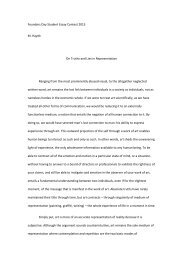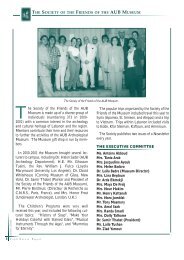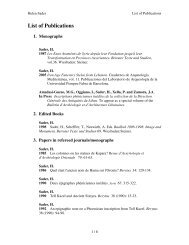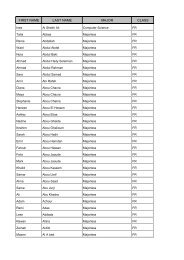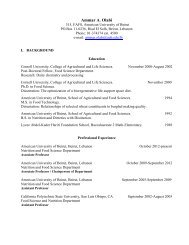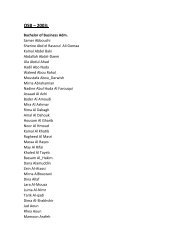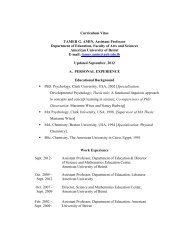The IX t h Makassed Medical Congress - American University of Beirut
The IX t h Makassed Medical Congress - American University of Beirut
The IX t h Makassed Medical Congress - American University of Beirut
Create successful ePaper yourself
Turn your PDF publications into a flip-book with our unique Google optimized e-Paper software.
T h e I X t h M a k a s e d M e d i c a l C o n g r e s s<br />
Effects <strong>of</strong> LCPUFA on the immune system<br />
Today it is clear that LCPUFA play a key role in the modulation <strong>of</strong> the immune system in many<br />
diseases. In addition to pro-inflammatory effects, prostaglandin E 2 –produced from (n-6) PUFA-<br />
exerts effect on the Th1/Th2 balance. It decreases the production <strong>of</strong> the Th1-type cytokines<br />
interferon (IFNg) and interleukin 2 (IL-2), enhances the production <strong>of</strong> Th2-type cytokines IL-4 and<br />
IL-5, and promotes IgE synthesis by B-cells.<br />
(n-6) PUFA are essential in relation to a thymus/thymocyte accretion <strong>of</strong> AA in early development,<br />
and the high requirement <strong>of</strong> lymphoid and other cells <strong>of</strong> the immune system for AA and LA<br />
for membrane phospholipids. Low (n-6) PUFA intakes enhance whereas high intakes decrease<br />
certain immune functions. AA metabolites can limit or regulate cellular immune reactions and<br />
can induce deviation toward a Th2-like immune response. By competition with AA for several<br />
enzymatic pathways (ie prostaglandin production), (n-3) LCPUFA influence the Th1/Th2 balance.<br />
As mentioned above, (n-3) LCPUFA induce also direct alteration <strong>of</strong> gene expression through<br />
modification <strong>of</strong> transcription factor activity such as nuclear factor kappa B (NFkB). NFkB plays a<br />
role in inducing a range <strong>of</strong> inflammatory genes including cyclooxygenase (COX-2), intercellular<br />
adhesion molecule (ICAM-1), vascular cell adhesion molecule-1 (VCAM-1), E-selectine, tumour<br />
necrozing factor (TNF-a), IL-1b, inductible nitric oxide synthase (iNOS), acute phase protein, in<br />
response to inflammatory stimuli. (n-3) LCPUFA decrease the activity <strong>of</strong> NFkB, via the inhibition <strong>of</strong><br />
IkB, the inhibitory subunit <strong>of</strong> NFkB. (n-3) LCPUFA are natural ligands <strong>of</strong> nuclear receptors such as<br />
PPAR a and g PPAR are ligand-activated transcription factors present in a variety <strong>of</strong> cell types<br />
including inflammatory cells. (n-3) LCPUFA have also been shown to influence the expression <strong>of</strong><br />
adhesion molecules (ICAM-1, VCAM-1 and E-selectin). Adhesion molecules direct the leucocyteendothelium<br />
interactions, transendothelial migration <strong>of</strong> leucocytes and leucocyte trafficking in<br />
general.<br />
LCPUFA and immune function in early life<br />
A few studies have suggested that early intervention with (n-3) LCPUFA may influence immune<br />
functioning and may affect the cytokine phenotype during development. Some <strong>of</strong> these studies<br />
demonstrated that early exposure to (n-3) LCPUFA during foetal and neonatal period has a<br />
prolonged impact on Th1/Th2 immune responses and T cell cytokine pr<strong>of</strong>iles. Maternal fish oil<br />
supplementation during the first 4 months <strong>of</strong> lactation resulted in an increased production <strong>of</strong><br />
lipopolysaccharide-induced IFNg upon stimulation in 2.5 y old children, whereas IL-10 production<br />
was similar than the olive oil group. <strong>The</strong> IFN-g/IL-10 ratio was two-fold higher in the fish oil group<br />
and was positively correlated with EPA/DHA in erythrocytes at 4 months. Adding DHA + AA<br />
to a standard infant formula for healthy infants increased the proportion <strong>of</strong> antigen mature<br />
(CD45RO+) CD4+ cells, improved IL-10 production, and reduced IL-2 production to levels not<br />
different from those <strong>of</strong> human milk-fed infants. Healthy term infants receiving at age 2 weeks<br />
the same formula supplemented with ARA and DHA produced less TNF-a (unstimulated) and<br />
had a higher CD3+CD44+ cells before stimulation with phytohemagglutinin and higher CD11c+<br />
cells post-stimulation. Compared with formula fed controls, the infants receiving LCPUFA had an<br />
immune cell distribution (higher percentage CD3+CD44+ and CD4+CD28+ cells) and cytokine<br />
pr<strong>of</strong>ile (lower production <strong>of</strong> TNF-a post-stimulation) that did not differ from breath-fed infants.<br />
All these results demonstrate that early diet influences both the presence <strong>of</strong> specific cell types<br />
and function <strong>of</strong> infant blood immune cells.<br />
38






